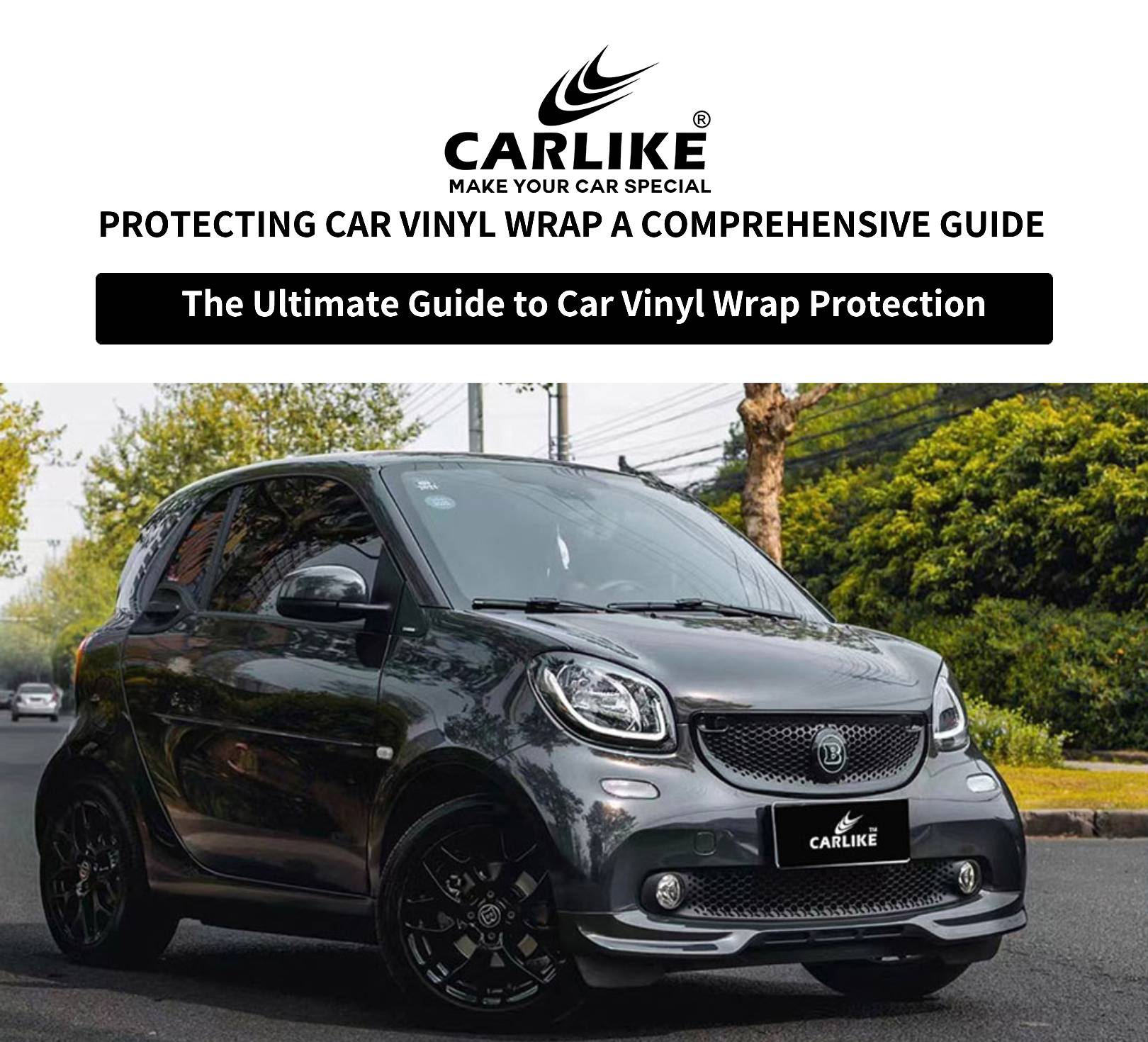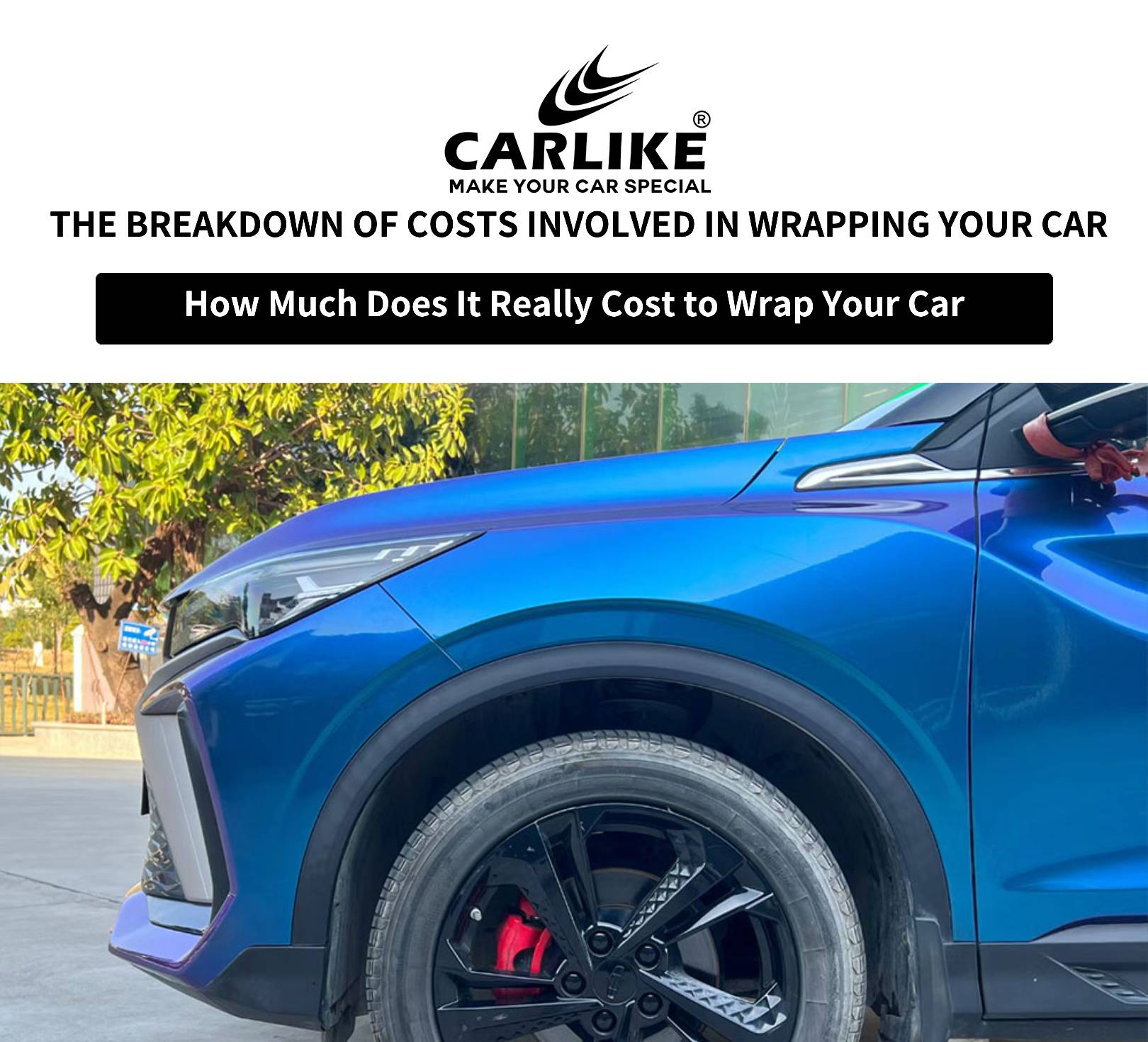CARLIKE launched in 2012, a professional car wrap vinyl manufacturer, mainly focus on premium car wrapping vinyls, with rich colors and stylish designs. High performance with economic price is always the persuit of CARLIKE.
What is a Car Wrap?
Car wraps are vinyl films applied to the exterior of vehicles to change their appearance. They come in various colors, textures, and finishes, allowing for customization without altering the original paint. Popular for their versatility, car wraps protect paint from wear, provide advertising space, and offer a temporary or permanent style change. They appeal to car enthusiasts, businesses for branding, and individuals seeking personalization without the commitment of permanent alterations.
Factors Influencing the Cost
Vehicle Size and Type
The size and type of the vehicle are primary factors. Larger vehicles like SUVs, trucks, or vans require more vinyl material compared to smaller cars, which increases the overall cost. The shape and complexity of the vehicle’s body can also impact the amount of material needed and the time required for installation, further influencing the price.
Material Quality
The quality of the vinyl wrap significantly affects the cost. Premium brands like 3M and Avery Dennison are known for their durability, color retention, and ease of application. While these higher-quality materials are more expensive upfront, they often provide better long-term results, resisting fading, peeling, and other forms of wear and tear more effectively than lower-quality alternatives.
Color and Finish
The choice of color and finish can also drive up costs. Standard colors are usually more affordable, while specialty finishes—such as matte, gloss, satin, chrome, or chameleon—tend to be pricier due to the additional production processes involved. These finishes create unique visual effects and can add a distinctive touch to the vehicle, but they come with a higher price tag.
Custom Designs
Opting for custom designs, graphics, or patterns adds another layer of cost. Creating and printing a custom wrap involves design work, precise printing, and often more complex installation. This customization allows for complete personalization of the vehicle’s appearance, but it requires more time and expertise, resulting in higher costs.
"CARLIKE-Make Your Car Special.”
Installation Costs
1. Professional Installation:
- Cost: Professional installation typically ranges from $1,000 to $5,000 or more, depending on the size of the vehicle, complexity of the wrap design, and the reputation of the installer.
-
Process:
- Surface Preparation: This includes cleaning the vehicle thoroughly to ensure the vinyl adheres properly and removing any existing paint imperfections.
- Application: Professional installers have the expertise to apply the vinyl wrap accurately, minimizing the risk of bubbles, creases, or misalignment.
- Quality Assurance: They ensure a flawless finish, often providing a warranty on their workmanship and the vinyl itself.
2. DIY Option:
- Cost: DIY kits can range from $200 to $800, depending on the quality and size of the wrap.
-
Process:
- Preparation: Similar to professionals, DIYers need to clean the vehicle meticulously and ensure a smooth surface.
- Application: DIY requires patience, as applying the vinyl correctly without trapping air bubbles or misaligning the design can be challenging.
- Skill Requirement: It demands a steady hand and familiarity with the process to achieve a professional-looking result.
3. Considerations:
- Time: DIY installations generally take longer than professional ones due to the learning curve and meticulous application process.
- Quality: Professional installers often use higher-quality materials and have access to tools that ensure a longer-lasting and more durable finish.
- Warranty: Professional installations often come with warranties that cover both the labor and the vinyl itself, providing peace of mind against defects and premature wear.


Long-Term Maintenance and Costs
1. Maintenance Costs
-
Regular Cleaning and Care:
- Routine Washing: To maintain the wrap’s appearance and extend its lifespan, regular washing is essential. It’s recommended to wash the car every two weeks using mild detergent and a soft cloth or sponge. Avoid using abrasive cleaners, as they can damage the wrap. This routine helps to prevent dirt and contaminants from becoming embedded in the wrap, which could lead to premature wear.
- UV Protection: Prolonged exposure to the sun can cause the wrap to fade over time. Applying a UV protectant designed for vinyl wraps can help preserve the color and finish. This additional step might incur costs, depending on the products used.
- Spot Cleaning: Bird droppings, tree sap, and other contaminants should be removed as soon as possible. These substances can damage the wrap if left untreated, potentially leading to more significant repairs down the line.
2. Replacement and Repairs
-
Partial Replacements:
- Over time, certain areas of the wrap, especially those exposed to more wear (like the hood, front bumper, or mirrors), might show signs of damage or wear before the rest of the vehicle. Replacing these sections individually is more cost-effective than rewrapping the entire car.
-
Repairs for Minor Damage:
- Minor damages, such as scratches, peeling edges, or bubbles, can sometimes be repaired without replacing large sections. However, the cost will vary depending on the extent of the damage and the labor required. Professional repair services are often necessary to ensure the wrap’s integrity and appearance.
-
Complete Wrap Replacement:
- Typically, a high-quality wrap lasts between 5 to 7 years, depending on factors like the quality of the wrap, environmental conditions, and how well it’s maintained. After this period, the wrap may start to degrade, requiring a full replacement. The cost of a full replacement is comparable to the initial installation, so budgeting for this in the long-term is important.
Summary
While the initial cost of wrapping a car can be significant, regular maintenance and addressing repairs promptly can help extend the life of the wrap and keep long-term costs manageable. Over time, expect to incur expenses related to cleaning products, minor repairs, and potentially partial or full wrap replacements, depending on the vehicle’s use and environmental conditions.
Cost-Saving Tips
1. Choose Standard Colwrapors
-
Lower Material Costs:
- Opting for standard colors like black, white, or matte finishes can significantly reduce material costs. These colors are usually more affordable because they are produced in larger quantities and are easier to match if repairs are needed.
-
Easier Maintenance:
- Standard colors are generally easier to maintain because they don't show dirt and imperfections as easily as more exotic finishes, such as chrome or metallic films. This can lead to lower long-term maintenance costs.
2. Install the Wrap Yourself
-
DIY Installation:
- If you have the time, patience, and some technical skill, installing the film yourself can save you a significant amount of money on labor costs. Professional installation can be expensive, so doing it yourself allows you to avoid this expense.
-
Use Tutorials and Kits:
- There are numerous tutorials available online that can guide you through the wrapping process. Additionally, some companies offer DIY wrap kits that include all the necessary tools and instructions, making the process more accessible to beginners.
-
Practice on Smaller Areas:
- If you're new to wrapping, consider practicing on smaller sections of the car, like the mirrors or roof, before attempting to wrap the entire vehicle. This helps you build confidence and skill without risking a costly mistake on more prominent areas.
3. Consider Partial Wraps
-
Focus on High-Impact Areas:
- Instead of wrapping the entire vehicle, consider a partial vinyl film. For example, you can wrap just the hood, roof, or side panels. This approach still provides a custom look while significantly reducing material and labor costs.
-
Accent Films:
- Using films as accents rather than covering the entire vehicle can be a cost-effective way to enhance your car’s appearance. For example, wrapping only the mirrors, spoilers, or interior trims can provide a stylish look at a fraction of the cost.
4. Use High-Quality But Affordable Brands
-
Research Budget-Friendly Options:
- Some brands offer high-quality vinylfilms at more affordable prices. While they may not have the prestige of premium brands, they can still provide a durable and visually appealing film. Researching reviews and customer feedback can help you find a brand that balances cost and quality.
-
Compare Prices:
- Prices can vary significantly between suppliers. Take the time to compare different brands and suppliers to find the best deals without compromising on the quality of the material.
5. Plan for the Long Term
-
Choose Durable Films:
- Investing in a more durable vinyl might cost more upfront but can save money in the long run by reducing the need for replacements or repairs. Quality wraps often last longer and maintain their appearance better than cheaper alternatives.
-
Regular Maintenance:
- Properly maintaining your wrap can extend its lifespan, helping you avoid the cost of early replacement. Regular washing, protecting it from prolonged sun exposure, and addressing minor damages promptly can keep the wrap looking new for longer.
Summary
To save on car wrap costs without sacrificing quality, consider choosing standard colors, exploring DIY installation, opting for partial wraps, and selecting budget-friendly yet high-quality brands. By making strategic decisions, you can achieve a custom look for your vehicle while keeping expenses under control.





